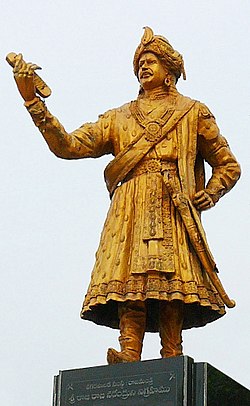Rajaraja Narendra
| Rajaraja Narendra | |
|---|---|
 Statue of King Rajaraja Narendra founder of Rajahmundry city | |
| Reign | c. 1019 – c. 1061 |
| Predecessor | Vimaladitya |
| Successor | Shaktivarmam II |
| Spouses | Amangai Devi |
| Dynasty | Eastern Chalukyas |
| Religion | Hinduism |
| Chalukya dynasties |
|---|
Rajaraja Narendra (r. 1019 – 1061 AD) was the Eastern Chalukya king of the Vengi kingdom in South India. Rajaraja Narendra established the city Rajahmahendravaram (Rajahmundry). His period was famous for Social and Cultural heritage. During the time of Rajaraja Chola I, Rajahmundry was sacked by Western Chalukya. The region witnessed the war between Western Chalukya and other neighbouring dynasties and political support by Chola dynasty.
Amangai Devi, daughter of Rajendra Chola I, married Rajaraja Narendra Chalukya, who is the son of Vimaladitya Chalukya. The feudatorial relationship with the powerful Cholas and Powerful Chalukya continued for three centuries from Arinjaya Chola.
The son of Rajaraja Narendra Chalukya, Rajendra Chalukya who also called Kulottunga Chola I went for a raid up to Kedah (Indonesia) for his maternal uncle. He became the king of the Chola empire in Gangaikondacholapuram when a political vacuum occurred. He then merged the Chola and Chalukya dynasty.
He is the first king of Chalukya Cholas. He was a liberal ruler as several land grants were given to the members of the Shudra community who were generals and royal officials during his reign. As he relaxed tax, he also called 'sungam thavirtha cholan'.
Kubja Vishnuvardhana, the progenitor of Eastern Chalukyas, in his Timmapuram plates claimed to belong to the Manavya gotra.[1] The Aravidu dynasty of Vijayanagara empire claimed descent from Rajaraja Narendra, however, they belonged to the Atreya gotra, unlike their claimed ancestor.[2]
Literary works during his time[edit]
The eastern Chalukya Dynasty supported Jainism and Shaivism. Rajaraja Narendra was a Shaivite. He respected religious priests, Telugu, Sanskrit languages and religions. Rajaraja Narendra requested his teacher, adviser, and court poet Nannayya Bhattaraka to translate the Mahabharata into Telugu (who was only able to translate two and a half parvas of the same into Telugu).
See also[edit]
References[edit]
- ↑ A. Murali. Rattan Lal Hangloo, A. Murali (ed.). New themes in Indian history: art, politics, gender, environment, and culture. Black & White, 2007. p. 24.
- ↑ M. S. Nagaraja Rao, Mythic Society (Bangalore, India). The Chālukyas of Kalyāṇ̄a: seminar papers. Mythic Society, 1983 - History - 236 pages. p. 63.
{{cite book}}: CS1 maint: multiple names: authors list (link)